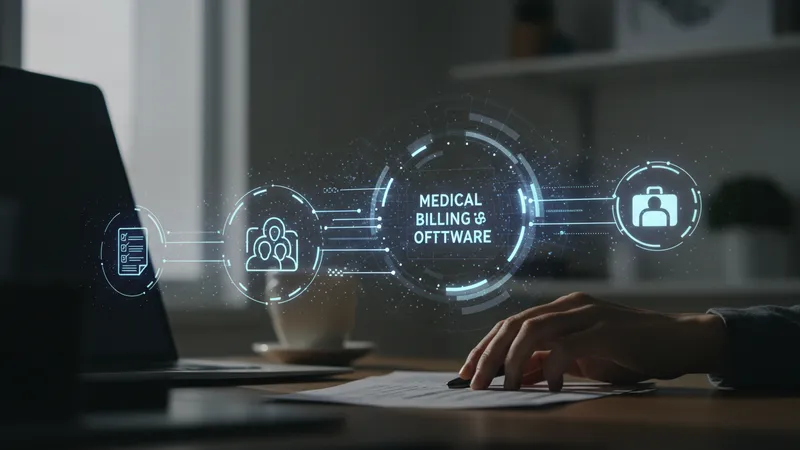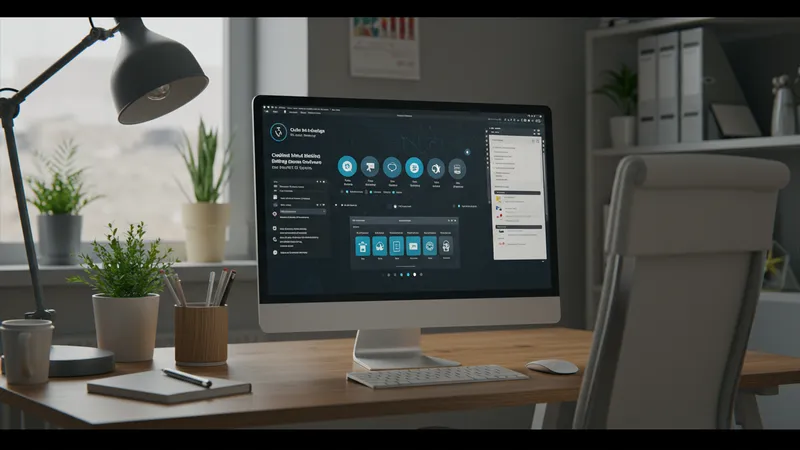Imagine discovering the secret weapon that home-based businesses are using to revolutionize medical billing — and it’s not what you would think. In 2025, this tool is transforming operations overnight.
With remote work at an all-time high, mastering medical billing from home isn't just convenient; it's essential. But there’s something game-changing happening that you need to know about.

For years, the world of medical billing seemed daunting, especially for small, home-based businesses. The complexity of handling insurance claims, patient statements, and the endless stream of paperwork seemed like an uphill battle. However, the introduction of intuitive software tools is reshaping this landscape, allowing even the smallest business to thrive. But that’s not even the wildest part…
You might assume that only large hospitals have access to top-tier billing systems, but with shifts in digital technology, even home-based entrepreneurs are tapping into advanced software options previously thought exclusive. This democratization is not only breaking barriers but also setting the stage for unprecedented growth within the industry. But the real shock lies ahead…
What happens next shocked even the experts who studied the industry for decades. You’re about to discover insights that could redefine how home businesses tackle medical billing. Ready to uncover these groundbreaking revelations? Keep reading as there’s much more to this story...
The future of medical billing is flying high in the cloud, and this shift is happening faster than anyone expected. Cloud-based solutions are offering unprecedented flexibility for medical billing software users. The benefits go beyond just remote access; these platforms offer real-time updates, seamless integration with existing systems, and data security that’s second to none. For home-based businesses, this means they can operate with technological confidence previously unavailable, but there’s one more twist…

The knock-on effect of this shift is a dramatic reduction in operational costs. With no need for expensive server maintenance or onsite IT staff, businesses can allocate more resources to growth initiatives. This democratization of technology is breaking down barriers, making premium features available to even the smallest players in the industry. But what you read next might change how you see this forever.
Cloud technology is indeed a game-changer, but it requires a change in mindset. Home-based businesses must embrace new learning curves, often seeking expertise and tools to stay ahead. Emerging platforms are stepping up to offer intuitive training and support, ensuring that users no longer feel overwhelmed by new systems. But it’s not just about adapting; it’s about conquering and thriving in this digital age. However, the benefits don’t stop there…
Cloud solutions are also ushering in an era of interconnectivity like never before. Integrated systems are allowing seamless communication between billing, insurance processing, and patient management. This means no more juggling disconnected systems or losing valuable data. The leap towards full integration is a revelation for those who know its potential, and the outcomes can transform a business’s operational efficacy. But the final layer of this puzzle is yet to be revealed…
Imagine a world where medical billing errors become a thing of the past. With AI-driven systems, we're closer to this reality than you might think. AI technology is being integrated into billing software to predict errors, automate repetitive tasks, and make more informed decisions instantly. For home-based businesses, this means significantly reducing time spent on administrative tasks and improving accuracy, but there’s an aspect of AI that’ll catch you off guard…

A pivotal advantage of AI is its learning capability. The system constantly evolves by analyzing data patterns, adapting to changes in billing regulations, and enhancing fraud detection processes. This adaptability is not just innovative but necessary, especially as billing rules become increasingly complex. What's more, home-based businesses can scale without fear of outgrowing their systems. Yet, there’s another revealing angle…
AI isn't just a backend savior; it’s reshaping customer service within the field. Through chatbots and virtual assistants, small businesses can manage patient queries and feedback swiftly without the need for additional staff. This increased efficiency translates directly to better patient satisfaction and loyalty. And as you might expect, this has industry insiders buzzing with excitement about what’s next…
Despite all this, the adoption of AI involves a critical obstacle: the fear of losing the human touch. To counter this, leading companies are focusing on hybrid models, where AI complements human expertise rather than replaces it. It's this blend of technology and human insight where the real magic happens. The exciting part? How these developments blaze trails in a rapidly digitizing world is exactly what we're about to uncover…
A major overlooked aspect of adopting advanced medical billing software is the broad spectrum of cost benefits. Yes, the upfront costs might seem hefty, but dig a little deeper and you'll uncover significant long-term savings. The savings are not just monetary; they extend to time, accuracy, and employee satisfaction, which together, create a robust operational model for home-based businesses. But there’s a hidden gain that few recognize…

Many software providers offer scalable pricing models designed to cater to growth. This ensures that as your practice evolves, you’re not locked into expensive plans that far exceed your needs. Additionally, these systems boast minimal downtime and greater reliability compared to outdated methods, saving costs associated with errors and rework. The financial flexibility afforded by these solutions is invaluable, yet what follows might challenge your assumptions further…
Beyond direct savings, think of the possibilities that come with increased productivity. Employees can now focus on high-level tasks rather than mundane, repetitive billing chores. This not only enhances morale but also fuels innovation. By freeing workers from administrative shackles, businesses unleash their team's full potential, which can drive growth and lead to competitive advantages. The next revelation, however, offers an even deeper perspective...
The market is also recognizing the aggregate value that comes with transparency and data-driven insights. By leveraging real-time analytics, businesses can better forecast financial trends, optimize payment cycles, and fortify cash flows. This approach not only boosts financial health but also creates a valuable resource for strategic planning. Your intuition tells you there’s more to this story, and your instincts are spot on. Let's delve deeper…
Integration may sound technical, but it is a simple concept changing medical billing forever. The ability to synchronize medical billing software with other systems is vital for efficiency and accuracy. Gone are the days of manually transferring data across various platforms; integration is offering seamless connectivity. This is transformative for home-based businesses, yet there’s an unexpected dimension you must understand…

Unified systems provide a single source of truth, which is enough to revolutionize workflow. This transparency is crucial in creating an accurate, real-time perspective on financial health, leading to informed decision-making. In an era where time is money, integration reduces redundancies, making the overall process leaner and more competitive. However, the advantages stack even higher than you might realize…
Another layer to consider is patient experience. Integration simplifies operations for the business but also enhances the patient journey – from appointment scheduling to billing and follow-up care. Patients appreciate having a streamlined experience without bureaucratic hurdles, leading to improved satisfaction and retention. The opportunity here is remarkable, but there’s still more around the corner…
Lastly, integration encourages innovation. Once freed from mundane tasks, business owners and employees alike can focus energy on developing new services, expanding markets, or improving existing offers. This potential to innovate can drive both personal and professional growth, giving businesses key insights that others may overlook. Curious about where this journey takes us next? The narrative gets richer and more intricate…
The software tools are cutting-edge, but the most enduring change might be in user experience design. Modern medical billing software boasts intuitive user interfaces which are pivotal in reducing learning curves and improving overall satisfaction. Home-based businesses are learning that usability translates directly to productivity, which is setting a new standard. Yet, user experience impacts more than efficiency…

Gone are outdated systems notorious for poor navigation and accessibility issues. The new era places the user at the core of design processes influenced by consumer tech; this shift means software that anyone can navigate with minimal training. Ease of use drives adoption, reducing resistance to digital transitions, and allowing staff to focus on core tasks. But wait until you hear the part about user feedback…
User-centric design doesn’t stop at ease of use. Continuous improvement relies on user feedback loops. Providers are leveraging real-time data and use cases to refine features and respond to unique needs promptly. This iterative process keeps systems at the forefront of innovation, ensuring they remain relevant and comfortable. But even as changes enhance, something profound emerges from this cycle…
Positive user experiences contribute significantly to lowering employee attrition rates. When staff feel equipped and comfortable with tools, job satisfaction increases alongside productivity, which lessens turnover and boosts employee loyalty. This healthier work environment is beneficial for both emotional welfare and business longevity. But hold on; another vital point beckons just ahead…
In the age of digital transformation, security isn't just an add-on; it's the foundation of a reliable billing system. Cyber threats are growing sophisticated, making robust security strategies an absolute must for home-based businesses. The importance of data encryption and stringent access controls cannot be overstressed, but this is far from the whole story...

Data breaches can inflict significant damage, both financially and reputationally. Medical billing software must comply with regulations like HIPAA to protect sensitive patient data. This safeguards not only the client but also the business owner from potential liabilities. The constant evolution of threats demands a proactive approach to security. There's more than one layer to peel back, though…
The advancements in security technology are paving the way for next-level measures, including biometric authentication and real-time threat detection. These aren't just buzzwords but essential elements in the arsenal against data theft. Such features instill a high level of trust, leading to stronger client relationships and an enhanced reputation for the business. But as you might suspect, there’s yet another layer here…
Equally crucial is maintaining an internal culture of security awareness. Training all staff to recognize phishing threats and ensuring rigid adherence to security protocols enhances the protective barrier around business operations. The convergence of technology and human vigilance spells a secure future, but we're just starting to see how deep this can go…
Automation in billing is more than a trend; it’s revolutionizing how tasks are executed, enabling home-based businesses to compete with larger entities. Automated systems streamline repetitive tasks, drive efficiencies, and reduce human error. Despite these advantages, there's another aspect of automation that will intrigue you…

The sheer speed of automation offers unprecedented time savings. Tasks that used to take hours or even days are now accomplished in minutes. This efficiency doesn’t just save time; it leads to faster payment cycles and improved cash flow, which are critical for maintaining growth. However, automation holds another compelling secret…
Smart billing systems are now equipped with predictive analytics. They anticipate trends and identify potential problems before they arise, allowing businesses to take preventive actions rather than reactive ones. This transition to a proactive operational stance is a game-changer for strategic planning. What’s more, is that this might only scratch the surface of potential…
Lastly, the role of automation extends to customer engagement. Automating invoices, reminders, and follow-ups improves client interactions, resulting in better relationships and increased retention. The seamless nature of automation also feeds into a brand's reputation, presenting an image of professionalism and reliability. Yet, there’s one more angle where automation is just beginning to dazzle…
Leveraging data analytics in medical billing has become an untapped goldmine for home-based businesses. Beyond keeping tabs on basic metrics, advanced analytics offer deep insights into operations, customer behavior, and financial trends. This enhances transparency and supports informed decision-making, but there’s another dimension to consider…

Data analytics go beyond pie charts and graphs. Predictive analytics provide foresight into consumer demands and operational shifts, offering a competitive edge. By anticipating changes, home-based businesses can remain agile and responsive, outperforming competitors who rely solely on historical data. Yet the narrative deepens further…
By analyzing collected data, businesses can also spot inefficiencies and streamline processes. Resource allocation becomes more strategic, lowering costs and removing wasteful procedures. Such optimizations bring about a higher level of productivity and profitability unprecedented for smaller entities. But that’s merely one piece of the puzzle…
Finally, analytics support personalized experiences. Analyzing patient interactions helps refine services tailored to individual needs. This personal touch boosts client satisfaction and loyalty, setting a precedent for how home-based businesses deliver services. The complexities of data reveal an unfolding story that only continues to grow richer…
The medical billing industry is notorious for having steep barriers to entry, but innovative software solutions are lowering these gates dramatically. The simplicity and accessibility of current systems allow new players to enter with ease, changing the industry landscape. Yet, there’s another side to this you might not expect…

With fewer barriers, competition is increasing. This surge in new entrants forces existing businesses to up their game, promoting progress and innovation industry-wide. However, this competition isn’t just driving survival; it’s encouraging collaborative success, pushing the field to new heights. Moreover, an interesting pattern is emerging…
Many new entrants are turning to niche markets, providing specialized solutions catering to specific needs, yielding better satisfaction and loyalty. This specificity carves out new opportunities and dynamics, leading businesses into areas they may have overlooked. Yet, intriguingly, this isn’t where the shifts stop…
The declining barriers have also resulted in unique partnerships. Small businesses are teaming up with larger entities, leveraging each other’s strengths, creating synergies that were previously impossible due to competitive barriers. The face of medical billing is evolving, leading us to consider worthier possibilities on the horizon…
Navigating the labyrinth of regulations remains a significant challenge for medical billing, especially for home-based businesses that lack dedicated compliance teams. However, the latest software solutions are simplifying compliance management by automating many regulatory tasks. But there’s a regulatory maze still untraveled…

Regulatory requirements are constantly changing, making it difficult to keep up. Software tools that offer real-time updates and compliance alerts are proving invaluable. This proactive compliance management alleviates many of the headaches involved, but with advancements come hidden complexities…
Regulations are intensifying in regions globally, compelling businesses to adopt solutions with an international lens. Understanding and adapting to global compliance scenarios are growing priorities, requiring resources often underestimated. The result is a shift toward more agile solutions that preempt regulatory changes. Delve further, and a valuable clarity appears…
The future may hold even more stringent requirements; hence, businesses are advised to future-proof their operations. Prioritizing systems well-versed in regulation prepares businesses to pivot as needed while remaining compliant and competitive. Those who anticipate regulatory shifts and prepare are better equipped for long-term success. It’s a proactive game with high stakes…
As technology continues to evolve, the realm of medical billing is bracing for the next revolution. Emerging technologies such as blockchain promise both disruptive innovation and improved security. Their potential to streamline billing processes while ensuring data integrity is staggering, but this is only scratching the surface…

Blockchain’s ability to trace transactions securely and transparently holds promise for billing systems, enhancing trust and accountability. This advancement may redefine what’s considered standard in protecting sensitive data. However, this future tech presents new challenges beyond technical specifications…
There’s also the rise of the IoT (Internet of Things), where interconnected devices facilitate deeper insights into healthcare and billing data, optimizing processes further. These advancements are pioneering changes in data collection, leading to improved patient outcomes and system efficiencies all around. Yet, there’s an even more exciting prospect on the horizon…
While the future looks promising, the integration of emerging technologies poses hurdles of its own, including cost, implementation challenges, and market education. These are intricate considerations for businesses, but those adopting early stand to gain unparalleled advantages. It’s a dynamic future laden with possibilities, where technology is the key catalyst for transformation. But where does this journey take us next? They're shrouded in electrifying potential…
For home-based businesses, managing technology transitions is a stealthy yet formidable challenge. Ensuring smooth transitions when adopting new billing software is crucial yet often overlooked, leading many firms astray. However, there’s more at play beneath the surface…

Lack of robust change management can result in resistance from staff, impacting morale and productivity negatively. Preparing employees with comprehensive training programs ensures that transitions are swift and effective, leading to increased adoption and less frustration. But there’s a hidden component…
Acceptance of change hinges on cultural readiness. Business cultures that embrace innovation fare better as transitions become seamless. Fostering a culture of resilience and openness helps mitigate teething issues associated with new systems. There's more at stake than just technical adoption…
Addressing fear related to technological change is equally essential. Open communication and involving staff early in decision-making create ownership and ease anxieties about technological shifts. The return on investment here includes not only successful tech adoption but also a unified, forward-thinking team. Yet, where does this shuttle of preparedness land us? The story unfolds further…
The medical billing landscape is seeing growth in niche markets—specialized sectors with unique demands and opportunities. This trend allows home-based businesses to position themselves as experts in distinct fields, yielding higher customer satisfaction and retention rates. However, there's a broader context…

Businesses venturing into niche markets experience unrivaled depth in expertise and service offerings. It's not just about filling a gap in the market but crafting tailored solutions that specifically address the needs of their clients. The power this grants, however, is doubled-edged…
Specializing offers an alluring proposition but requires dedication to ongoing R&D to stay ahead. These ventures necessitate understanding dynamic regulations and staying vigilant with technological trends—demanding, but rewarding in the end. Still, the narrative twists slightly…
Niche markets encourage collaboration. Businesses often partner with tech providers to develop unique solutions to complex problems, fostering innovation. This level of specialization could very well be the hallmark of future industry leaders. We're drifting into overwhelming possibilities…
The medical billing software industry for home-based businesses is on the brink of a renaissance—a period rich with potential and innovation. The relentless march of technology introduces both challenges and opportunities that redefine how practices operate. Exciting days lie ahead for those willing to adapt.

This digital transformation era compels all players to reconsider their roles, pushing boundaries and embracing the future with vigor. The journey is only beginning, and as we navigate through this transformation, it promises advancement and prosperity for those who dare to embrace it head-on.
Feel the momentum? Share this guide with colleagues and join the conversation as we usher in the remarkable era of medical billing. Let the world know you're part of this change, bookmarking these insights as your roadmap to success.